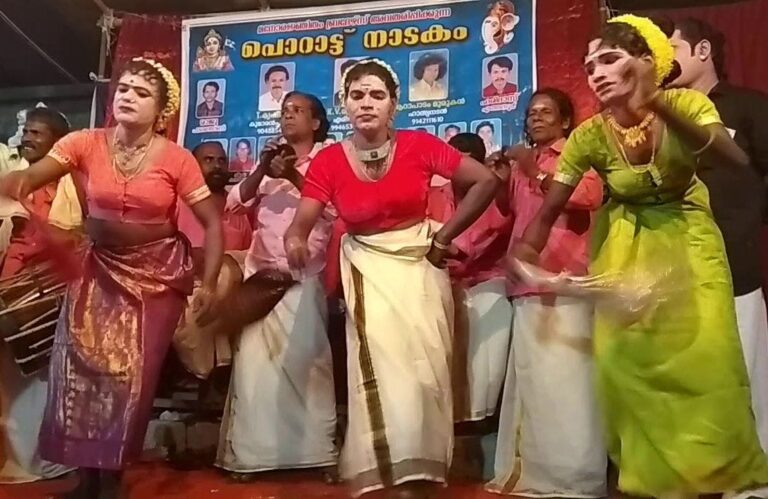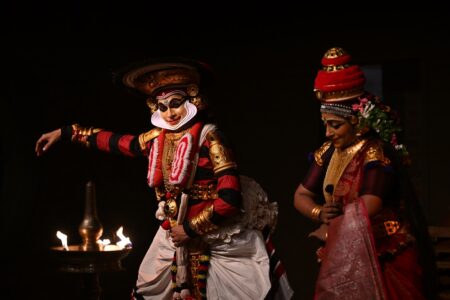A community of celebrities of a bygone era, the Paanan community’s Porattukali has contributed vastly to the impromptu style of other art forms
Paanan is a community under the tribal group (Adivasis), the indigenous population found in the southern Indian state of Kerala. Most of the tribal people of Kerala lived in the forests and mountains of Western Ghats, bordering Karanataka and Tamil Nadu, extending branches to the hilly and mountain terrains of the western border of Kerala. Some of the communities migrated to the rural planes and also closer to the urban sectors. Paanan is one among them.
People of the Paanan communitywere celebrities of a bygone era as they were believed to be in possession of certain powers and believed to have some sort of a mystical charm. As migrations continue down the Ghats, the community, as a whole, has been shifting in its culture, gradually akin more to that of the rural-urban transition zones. From my school days since 1958, I have been familiar with the Paanan community in the districts of Palakkad and Trissur. Each locality had its Paanan, whoenjoyed the goodwill of the entire locality. A Paananand his wife (Paatti) would together visit houses on certain auspicious days and occasions, to bring blessings upon the household. They would sit on the open ground in front of the house and sing with a thudi, a native percussion played by Paanan, and Paatti keeping rhythm with pair of small metallic cymbals. The song (paattu) was supposed to bring blessings to everyone in the house, especially the little ones. When a baby was born, it was customary for the Paananto visit that house and sing for the wellbeing of the new-born baby. The household would expect this and would shower gifts on the Paananand his wife.
During 1977-1995, I delved further into community in the Panayur village of the Palakkad district, studying Paanan Kali, a folk art form considered to be a prestigious theatre style of the community. The same was also referred as Porattukali. Porattu (Poram = outside and aattam = dance, drama, singing, etc.) is a performance done outside the defined temple precincts and in the courtyards of houses essentially due to the erstwhile social distancing that existed among different classes of people. Performances are arranged also on open fields after the harvest season. The art form, as such, has neither shown any significant evolution nor morphed into other forms. However, the themes and styles, in bits and fragments, can be identified in contemporary theatres, cinema and dance styles.

The style and presentation of Paanan Kali
The theatre is predominantly verbal (vaachika abinaya) and rendered as songs accompanied by harmonium, mrudangam, thudi, small thappu (kanjira) and a pair of cymbals (elathaalam). The actors adopt a free dancing mode around a common frame of native kinesics, rendering the lyrics in a native style. The innovative free movements shown by the modern singers on stage shows do point towards those of the Paanan kali
Each long segment of a song ends with a kalasham (the summing up dance of movements). The aahaarya (costumes, ornaments and face makeup) is realistic and flexible, according to the availability and popularity of materials. There are fixed texts as well as innovative ones covering certain incidents or stories from mythology, on legends, ancient poems and on subjects such as spirituality, material science, politics, sociology, etc. Interestingly, just like classical dance art forms, the presentation has a repertoire – invocation or the Devatha Vandanam (any of the known deities); Daasiyattam/Sabhaavandanam; Kaashi-pandaram or Sanyaasinilayam; Jnaanakkummi; and Porattu ending with a Mangalam.
In the Porattu section, characters are featured as couples who represent various professional communities and are accompanied by a jester (mediator). The communities often presented are Kuravan and Kurathi (the palmist and his wife), Chaklian and Chakliathi (the cobbler and his wife), Cheruman and Cherumi (the field workers), Mannan and Mannaathi (the washerman and his wife) and Thottyan and Thottichi (the tattooist and his wife). In the main story, the male characters, Lord Shiva, Subrahmanya or Vishnu and females, their respective consorts, are often in a clash with their husbands. The pre-context episode is a common one. The divine couples take birth on earth as couples in the said communities, following a curse by a higher power. Or, at times, they heavily disagree on some incident and curse each other and take birth on earth.
All Porattu forms have a jester who mediates and discusses with the couples, resolve their disagreement and makes them realize who they actually are in their original forms. During the course of the above process, the most noteworthy technique to be studied is the way they do the vocal renditions and the subjects they refer to. The rendition observes the style of the community represented by the characters. As mentioned earlier, the topic of the performance could vary across incidents from epics, legends, history or even instances in the social scene. For example, it could be wrong-doings of a certain administration, or immoral traffic, all interpreted in a satirical manner. In this respect, the Paanan Kali’s Porattu section strikes close similarity to the Prabhandhakootthu presented by the Chakkyaar community.
Prabhandhakoothu is predominant in vaachika abhinaya, in which a single performer renders the slokas in well-structured Sanskrit. The Chakkayaar doing Prabhadhakoothu is often a scholar who interprets the slokas in Malayalam monologues. The objective of both art forms could be specifically interpreted as corrections of human ills to ensure social stability; to enhance knowledge of one’s own dharma and culture and contribute to the good of the society.
Two aspects of Paanan kali touch higher realms of human body science (like a bit of anatomy, say, gynaecology and embryology) as well as philosophy and spiritual science — ‘Sannyasinilayam’ and Jnaanakkummi’, respectively. The highlights of these two aspects have been explained below, thanks to the detailed information shared by Panayur Muthu ashan. Muthu was a highly ranked performer during his professional period who was noted especially for donning the female roles during his young and robust days. Highly intelligent and humble at the same time, Muthu graduated into a performer who could enact the role of the Sanyasi in the Sanayasinilayam, which is the ultimate test to determine the level of a performer. Often the efficiency got attested by scholars, whenever they observed the item.
The finer aspects of the dance form
Sannyasinilayam, Kaashi-Pandaaram and Jnaanakkummi are the heaviest items in the repertoire as it deals with material and spiritual science — all within the ambit of easy rural theatre system; quite frolic in its structure. The actors sing with light dance movements, keeping rhythm by tapping a small round wooden stick on a long bamboo plank. A pilgrim (Pandaaram/Pandaaran) sets forth to Kashi (Varanasi). On his way, he meets a mendicant (A sanyasi or a hermit, not on the stage at that moment) who smokes Ganja (Cannabis). On aggressively questioning the mendicant, he retorts from the temporary green room behind the performing area: “I have been sitting here for years, accepting whatever the pilgrims give me; using it in the manner as specified by the donor. I have never bothered to ask them the names of what they gave me. I do not know this is Ganja. Mind you! But I always self-experience the given materials.” The pilgrim asks \ “Ok! What do you experience when you smoke this?” Mendicant comes on to the stage (singing): – “The universal truth! Our body is a false one. (Kaayame ithu poyyeda, Shiva kaayame ithu mayyeda…) The body of Lord Shiva (the cosmos) alone is the truth.”
The hermit goes on to explain why it is so. As the pilgrim keeps questioning, the mendicant pursues a logical argument that the human body is a manifested one and anything that is manifested meets its end at a specified time, growing through the phases of growth, senescence and death. It is not immortal. But the body of Shiva is immortal. Gradually he explains how a human being is formed by the union of a sperm and an ovum (fertilisation), shapes of the embryo at various stages, the head getting set and the time-bound sequences of labour. The details also point out the right and wrong time of the union in a 24-hour cycle, as well as the virtues and defects, respectively. On questioning, why the human body is a false one, the mendicant explains the anatomy of the body — the number of muscles, bones, blood vessels, nerves, the amount of blood, fat; the amount of semen and number of ova produced respectively by a male and a female during their fertile period. Finally, the organ systems get packed up and covered by skin; nailed together by teeth and nails. All these basically match with the human embryology and anatomy, as given in the texts followed by the schools of medicine such as Ayurveda and allopathy.
In continuation, moving over to the spiritual aspects, the mendicant performs Jnaanakkummi. He says that such a manifested body, being immortal, is just an illusion (maaya). There is a note on the differences between perceptions in the conscious and the subconscious stages. Jnaana refers to absolute knowledge. Kummi is a kind of joyous dance. It has traces of the core syllables of the native rhythm scales such as Chembada, Triputa and Panchaari. This segment underlines how internally each one is like any other but displays different individual outputs in terms of attire, words, etc. The original text has several stanzas, each one pointing out the outer ‘illusion’ and the inner ‘real’ of each kind of person. For instance, the mendicant says, even a great sage is recognised by his lock of hair, long beard, saffron clothes and ash-smeared body, accompanied by his word of wisdom. A sage’s anatomy is the same as that of any other man, including that of an ignorant one. However, since he wears clothes and carries a decorum that provides him with the cover (illusion) to let others feel, he is considered the winner of the world (highly knowledgeable). The text refers to the concept of Kundalini and the Shadaadhaarachakras (the six wheel-like planes of energy) and how by a set of steady practices, one can mobilise the energy through the planes, to finally experience the spiritual bliss.
Almost all items have the lyrical section in light Tamil and Malayalam. However, the monologues or dialogues are always in colloquial Malayalam. According to Muthu ashan, the text used for Sanyasinilayam and Jnaanakkummi are based on an ancient text, Udalkkoor — believed to be the work of the Sidha poets. Dr. Padma Subrahmanya, during a discussion, had mentioned about the same text being used in certain Tamil folk plays. Thus, Paanankali, by virtue of its geographical disposition, theme concepts of rebirth of the deity couples and the dual language usage, represents a transcultural ancestry of Tamil Nadu and Kerala. Unfortunately, this frolic folk art that speaks of human cultural migrations, transmigrations has not been studied in depth. In order to examine the art form’s possible impact on a given social structure, the ancient yet updated scientific and spiritual wisdom do await deeper studies.




